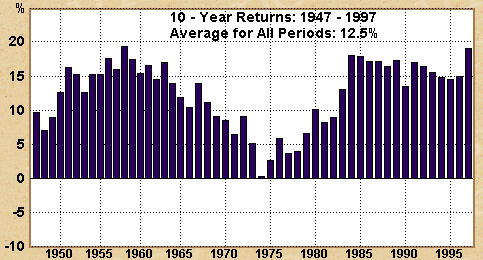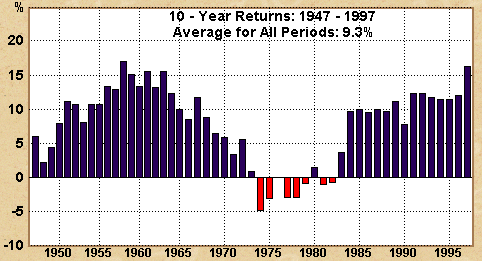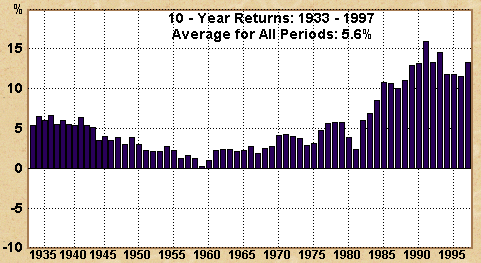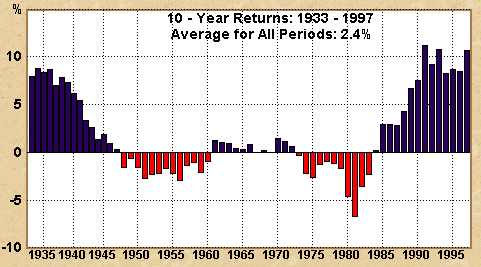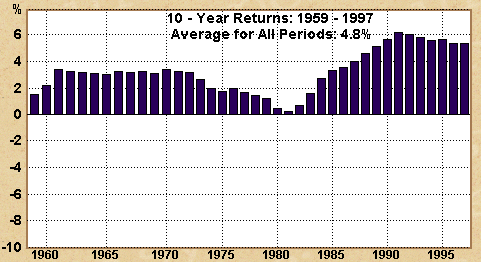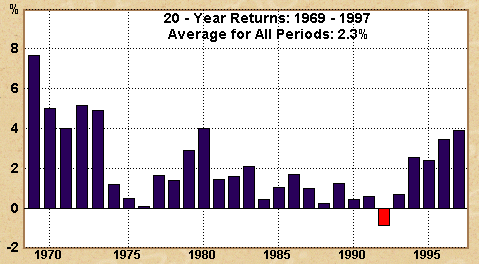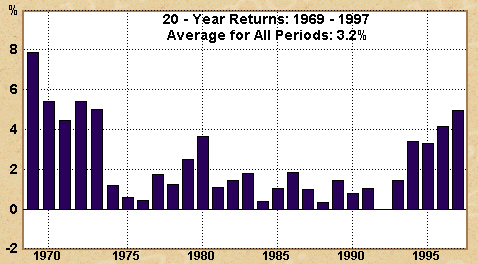Contents:
- ’Labour-sponsored funds suitability
- Further data showing the importance of foreign content in any RRSP
- A potentially good development: rebates on mutual funds
- Many loan opportunities for investors to use RRSP room
- ’The erosion of earnings: inflation’s impact on returns in various asset classes
- Peculiar evidence for the importance of communication and correct terminology
1, One of the attractions of RRSPs (and the reason for the disproportionate attention they get before the end of February) is the short term tax saving aspect. In fact, without this, probably even fewer people would invest in RRSPs for the sake of their main advantage, tax-deferred accumulation of capital. By saying this, I do not mean to deny the validity of the importance of tax deduction one can get due to registered investments. One the contrary, I want to mention a not widely known type of investment that has outstanding attractiveness from this point of view, beside other nice features. Below, I want to summarize the essence of so-called labour-sponsored funds.
Labour-sponsored funds are a special kind of mutual fund that offers additional tax-saving opportunity beyond the one other RRSPs do. These funds invest in growth oriented small and medium-sized Canadian businesses. If someone in a 50 % tax bracket invests $5000 into an RRSP, the tax deduction induced will be $2500. However, if the investment is made into a registered labour-sponsored fund, there is an additional tax deduction opportunity of $1500 in Ontario. Does it not sound beautiful, to have $5000 investment for actually paying only $1000 for it? Too good to be true, there must be some catch here, you may suspect, … and you are right if you do. Labour-sponsored funds are somewhat less liquid than mutual funds in general, and the majority of them achieved lower returns than many other mutual funds in the recent years. (There are convincing arguments that suggest that it will change and investing in small and medium size businesses will be more profitable in the coming years. Also, this typical under-performance recently was not a characteristic of all labour-sponsored funds at all; most other mutual funds would have been very happy with the annual 15% return achieved by the top performing labour-sponsored fund in 1998, e.g.) If you redeem your investment within 8 years, you have to pay back the additional 30% tax deduction. On the other hand, the 30 percent additional tax deduction at the beginning boosts the actual return for the investor tremendously. This boost means that if another registered investment is chosen, the long term annualized return there should be about 3 to 4 percent higher than in a labour-sponsored fund, just to catch up with the latter. Labour-sponsored funds are less volatile than most other funds, something that is going to become more important than it was before 1998. Finally, by investing in labour-sponsored funds investors can increase the 20% foreign content limit up to 40% within their RRSPs.
2, The issue of foreign content in long term investments is quite frequently discussed. The fact that the Canadian economy and stock markets play only a very small role in the world is quite well known. There is a perhaps-unanimous agreement among experts that the 20% limit allowed in registered plans today is excessively low. To achieve better returns and diversification, investors should aim at about 40% foreign content, beyond which the expected higher return is accompanied with higher volatility as well. It is even more surprising that only 20% of investors use fully the foreign content opportunity; in 60% of all RRSPs, there is no foreign content at all.
The following table shows the average annual returns of various funds in different categories in the last two years, in percentages:
|
|
1997 |
1998 |
|
1997 |
1998 |
|
Asian & Pacific Rim |
-24.07 |
-0.59 |
International Equity |
11.82 |
14.90 |
|
Balanced |
11.22 |
3.01 |
International Money Market |
3.55 |
4.67 |
|
Canadian Bond |
7.32 |
6.67 |
Labour-sponsored |
4.41 |
-2.95 |
|
Canadian Equity |
13.37 |
-3.00 |
Latin-American & Emerging Market |
3.82 |
-25.13 |
|
Canadian Money Market |
2.38 |
3.95 |
Mortgage |
3.69 |
5.43 |
|
Canadian Small-Mid Cap Equity |
11.12 |
-13.38 |
Precious Metals / Natural Resources |
-25.31 |
-27.11 |
|
Dividend |
19.20 |
-1.38 |
Sector Equity |
20.46 |
20.64 |
|
European Equity |
22.11 |
22.48 |
US & International Balanced |
11.16 |
12.96 |
|
International Bond |
4.41 |
9.86 |
US Equity |
27.56 |
23.28 |
|
Year |
First |
Second |
Third |
Fourth |
Canada's ranking of available markets |
|
1996 |
Venezuela |
Hungary |
Spain |
Sweden |
13 out of 36 |
|
1995 |
Switzerland |
USA |
Sweden |
Spain |
12 out of 36 |
|
1994 |
Finland |
Chile |
Korea |
Norway |
22 out of 33 |
|
1993 |
Hong Kong |
Malaysia |
Indonesia |
Luxembourg |
32 out of 33 |
|
1992 |
China |
Jordan |
Mexico |
Hong Kong |
21 out of 32 |
|
1991 |
Argentina |
Mexico |
Chile |
Venezuela |
20 out of 30 |
|
1990 |
Mexico |
Chile |
Korea |
UK |
21 out of 30 |
|
1989 |
Austria |
Mexico |
Indonesia |
Argentina |
18 out of 29 |
|
1988 |
Indonesia |
Korea |
Mexico |
Denmark |
17 out of 28 |
|
1987 |
Finland |
Japan |
Spain |
UK |
5 out of 22 |
|
1986 |
Spain |
New Zealand |
Italy |
Japan |
19 out of 21 |
3, You might have noticed the full page ads and a few articles about a new development in the mutual fund industry: rebates. These 2 to 3 percent rebate offers are commission decreases on deferred sales charge products, from the sellers’ point of view. From your own point of view, they work as relaxants on the conditions you accept when buying a deferred sales charge fund, namely, paying a decreasing percentage of the fund’s value as a sales charge if you redeem the money too early. Even more pleasant, if you do keep the money in a fund with such a rebate long enough (usually 5 to 8 years) then the rebate in fact becomes an actual bonus increasing the return.
Along with the increasing popularity of so called ‘no load funds,’ the introduction of rebate signals important changes in the financial business. These can be summarized as increasing competition between the banks, mutual fund companies, and other players and as a movement from commission-based toward fee-based compensation of advisors. Many people are probably not too happy with this development but I am, as you may know it from personal discussion or from reading what I have been posting on this issue on my web site since 1997. However, there are a few aspects in the way the rebate is presented to the public that I find slick, unfair and misleading. A few of my reservations are:
- First, certain ads suggest that the existence and size of the commission that mutual fund sales people get is usually kept secret. It might happen sometimes, but only if clear regulations about the disclosure of such information are breached, and if the investor is inattentive and naively trustful. The details of various charges and current and future remuneration are in the fund documents the investor gets and the sales person is obliged to discuss them with the client so that /s/he can make an informed decision. In these discussions, among other things, clear distinction should be made between back-end load and deferred sales charges, something that I saw at least in one whole page ad about the new rebate blurred.
- Second, just like the so-called non-load fund providers, the advocates of the rebate imply that every investor is better of by ‘going alone’, that is without the guidance financial advisors can provide. It is quite easy to offer arguments for the contrary, and numerous surveys have demonstrated the better investment results by people with advisors. This issue is somewhat similar to the controversy around the need for mutual funds, in the first place. According to a balanced, realistic approach, some people (with significant amount of money, enough expertise, time, interest, risk tolerance, and calm) are probably better off with more direct investments than mutual funds. However, for the great majority of people mutual funds really are the best form of accumulating money for long-term aims. I think it is a disservice to the public to nurture ill feelings about using financial professionals in general. Besides, I didn’t even mention its unfairness in a competitive situation where those generous rebates and no-loads still leave, of course, commission in the pocket of their providers.
- The companies that try to play the customer advocate role now seem to forget that there has been opportunity to decrease sales commission in the past already. It has been possible trough either negotiable front or back-load charges, their combination, or (at least with one company, recently) negotiable deferred sales charges. In this sense, the rebate is not such a novel idea. On the other hand, it is strange that individual sales persons are not allowed to rebate clients directly, they same way brokerages are doing now. In addition, it is conspicuous how easily the champions of rebate and no-loads tend to forget mentioning that investing into their products frequently incurs administrative charges and trustee fees that do not exist with many mutual funds.
All my reservations refer to the way the rebate has been introduced, not to the fact that they signal a new level of competition among fund providers. I think, the customer is definitely better off with the change: Those who have been doing their investing through brokerages can save money or achieve better returns. The majority, those who invest trough financial advisors / mutual fund sales people, will probably benefit from the wider publicity that negotiable sales charges get. In other words, there will probably be more funds available with negotiable deferred sales charges, and there will be more willingness from sales people to offer lower charges where it is allowed. However, the annual 0.2 to 0.3 percent additional growth that the one time rebate means (assuming about 7 to 9 year holding periods) can easily be lost if the selection of a portfolio is not done professionally, or if the investor cannot resist the temptations of outsmarting the market at every turn. Like many novelties in life, the new rebate creates chances to benefit from. Nevertheless, one needs a certain level of maturity and expertise to use those chances well, - and in a world where many people consider playing the lottery as a kind of investment or preparation for retirement, the advertisements I criticize can be dangerous.
4, The fierce competition among financial institutions is reflected also in the wide choice of sources of special loans for making people with unused RRSP room able to use that room. Many banks, and mutual fund and insurance companies offer easy access to such RRSP loans. The term of these loans is 1 to 5 years, and there frequently is an optional 90 to 120 day waiting period with the repayment. This feature allows the investor to wait with the commencement of repayment until the tax refund, due to the RRSP investment, arrives. The rates are usually a bit above the prime rate, but one can find rate below the prime as well. Good news for some people who perhaps slept over many demonstrations of the importance of RRSPs and the advantages of using borrowed money over leaving RRSP room unused, that some companies offer up to $50,000 loan for this particular purpose. It can easily be demonstrated that using RRSP room is preferable to paying down mortgage as well.
Most lenders offer these loans only for investments made in their RRSP eligible products. However, there is at least one source from where one can get very attractive RRSP loans without such kind of restriction. If you have friends, relatives, neighbors, or colleagues who you want to help with good advice, asking them about their use of RRSP rooms these days may be something they will say thanks to you for. It might sound naïve, and in some cases it surely is, … but don’t forget: too many people do not use their RRSP rooms to the extent they would be able to, and ignorance is probably part of the explanation why it is so. Compared to the nonsense of it, the low utilization of foreign content, cited above, is a minuscule one. Would you not
5, We all know, in principle, that the real purchasing power of investment returns is diminished by both taxes and inflation. The taxation issue is important when we discuss registered savings plans, and even when making decision about what type of investment we should prefer. The same nominal return from various types of investments is taxed differently. In the last newsletter, I promised something about the other half of this issue of purchasing power erosion: inflation’s effect. It is quite instructive to compare nominal vs. real rates of returns of various types of investments. Would you suppose, e.g., that in the 1924-97 period, there were 22 years when Canadian equities produced negative real rate of return, but for bonds, this number is 29? I could compile a nice little picture book from the many historic charts of this type that the proper financial planning software can churn out. For the moment, please be content with only some sampling. Below, you can see how ten year annual compound returns looked like for Canadian Equities, International Equities, Bonds, and GICs in the past, both in nominal and real term (that is in real purchasing power). Again, taxation is not considered here. Please notice that the scales are somewhat different in the various charts, due to the varying length of time of availability of the particular type of data, and to the different ranges of values to be demonstrated. Also, please make no mistake with presuming that since the right sides of these charts (that is data for more recent periods) are usually positive, the negative return of Canadian equities in 1998 was so exceptional. The real one-year return of Canadian equities was minus 19.8% in 1990, and Canadian bonds achieved a minus 10.7% return in 1994. True, GIC real returns were positive in each year since 1977, but it is also true, that GIC return in almost any longer period was substantially below return on equities.
|
|
Canadian Equities, nominal |
|
|
Canadian Equities, real |
|
|
International Equities, nominal |
|
|
International Equities, real |
|
|
Bonds, nominal |
|
|
Bonds, real |
|
|
GICs, nominal |
|
|
GICs, real |
The next chart shows that from the possible 29 twenty year periods from 1950 to 1997, there was only a single one (1973-92) when the annual compound return from GICs was higher than that of Canadian equities. As you can see, the average difference was 2.3%. Finally, in the last chart, again, GICs are used as a benchmark, but this time for a long term growth portfolio, consisting of 80% Canadian and 20% International equities. There was not a single 20 year period when GICs would have been better, and the annual average advantage of the portfolio was 3.2 %. Again, these charts show the additional annual returns these equity investments had achieved in various twenty-year periods, ending in the years shown in the charts, over and above GIC returns in the same periods.
|
|
Canadian Equities' nominal outperforming of GICs in twenty year holding periods |
|
|
Long term growth portfolio's nominal outperforming of GICs in twenty year holding periods |
6, This is the latest addition to the 'Jokes' page of my web site. I wonder if you will find it as instructive as I think it is.
One day, an excited man visited a respected surgeon, and asked him to castrate him. He told this would bring a happy turn in his life. The surgeon tried to object, than told: "Take at least a few days time of thinking. Don't rush into it, this thing is irreversible, you know." However, he insisted: "Doctor, I have pondered about it enough. Finally, I made up my mind, and if you are not willing to do what I want, I am going to other professional." He did not have to. Anesthesia, snip-snap, … and the job was done. While the patient was getting back his conscience, the doctor still tried to understand him, but he could not. Before the patient was sent home, he approached him again. "Your wish has been fulfilled, so at least now please explain to me what made you to have yourself castrated?" "Oh, of course, you don't understand," the man answered. "It's because you don't know that dazzling lady I got acquainted with some time ago. I am crazy for her, and she would not reject me either, ... but when I proposed her, she admitted that she is a devote Jew, and this makes marriage with a pagan like me quite impossible. I decided that for her sake, I will convert into a Jew myself, ... and you know their practice with a newborn male offspring, eh? Obviously, if I want to become a good Jew, I should start with that. I resisted the idea for a while but then understood that this is a very worthwhile sacrifice for gaining the appreciation of my sweetheart." "Oh gee," the doctor exclaimed, "Did you really mix up castration with circumcision? Don't you know that what some religions prescribe is not castration but circumcision?" The eyes of the happy future groom lit up with joy that he finally got it. "That's the proper expression I was looking for, doctor!" he shouted with great satisfaction to the flabbergasted surgeon.

Top page (on personal financial planning)
Key areas:
Life and health insurance (including disability, critical illness, and long-term care protection)
If you are / have ...
|
These web pages are for information purposes only. The information contained and presented, while based on and obtained from sources we believe to be reliable, is not guaranteed either as to its accuracy or completeness. The content of these web pages is solely the work of the author, Laszlo Kramar. The views (including any recommendations) expressed on these pages are those of the author alone, and they have not been approved by anybody. Neither the information nor any opinion expressed herein constitutes an offer, or an invitation to make an offer, to buy or sell any product discussed or referred to in these web sites. These web pages are for educational purposes only and are not intended for use by residents of the United Sates; nor are they intended as an offer or solicitation in any jurisdiction outside of Ontario, Canada. Commissions, trailing commissions, management fees and expenses all may be associated with mutual fund investments. Please read the prospectus before investing. Mutual funds are not guaranteed, their values change frequently and past performance may not be repeated. |
(c) Copyright 1997-2006 László Kramár. All Rights Reserved.


